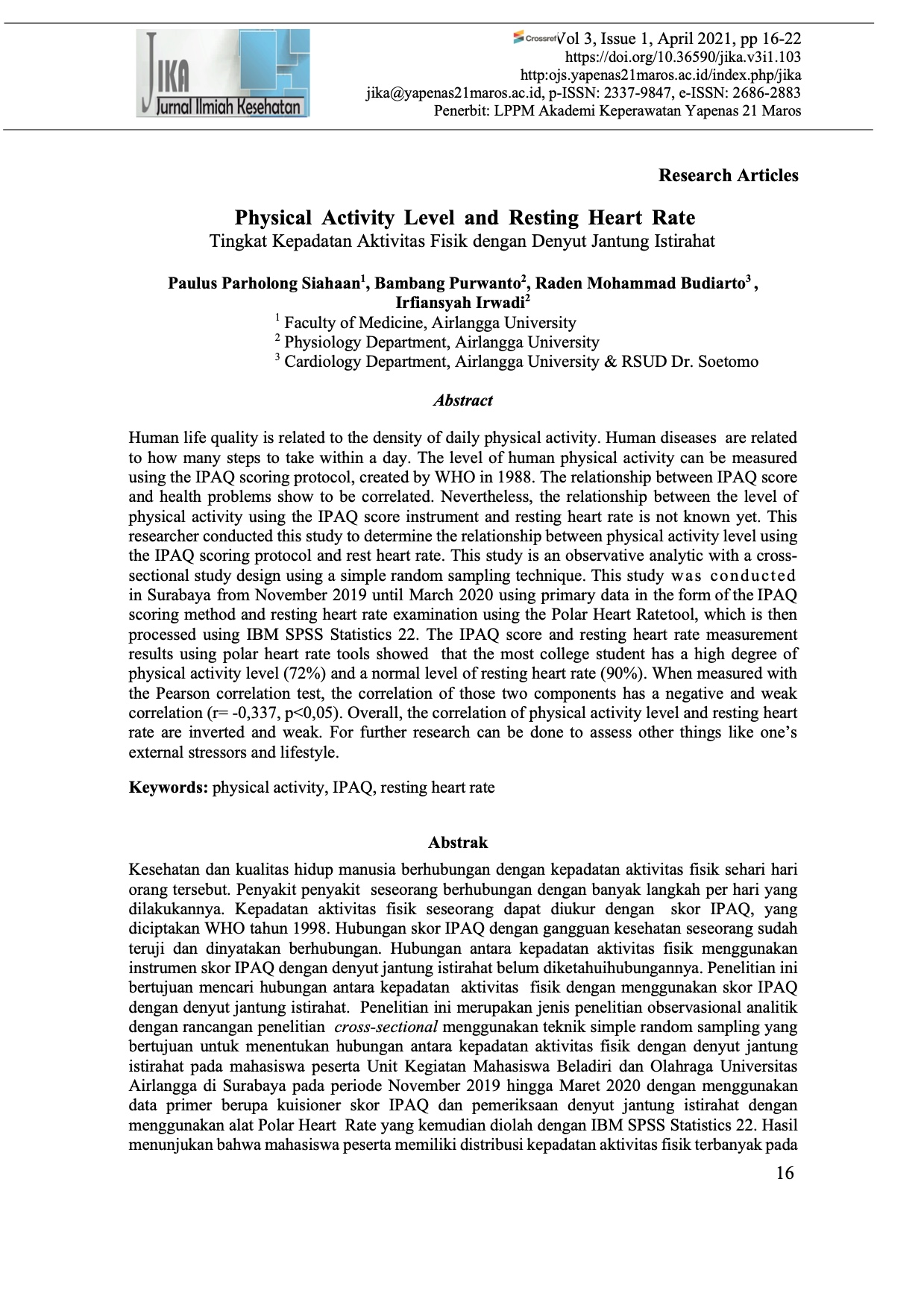Physical Activity Level and Resting Heart Rate
DOI:
https://doi.org/10.36590/jika.v3i1.103Keywords:
physical activity, IPAQ, resting heart rateAbstract
Human life quality is related to the density of daily physical activity. Human diseases are related to how many steps to take within a day. The level of human physical activity can be measured using the IPAQ scoring protocol, created by WHO in 1988. The relationship between IPAQ score and health problems show to be correlated. Nevertheless, the relationship between the level of physical activity using the IPAQ score instrument and resting heart rate is not known yet. This researcher conducted this study to determine the relationship between physical activity level using the IPAQ scoring protocol and rest heart rate. This study is an observative analytic with a cross-sectional study design using a simple random sampling technique. This study was conducted in Surabaya from November 2019 until March 2020 using primary data in the form of the IPAQ scoring method and resting heart rate examination using the Polar Heart Rate tool, which is then processed using IBM SPSS Statistics 22. The IPAQ score and resting heart rate measurement results using polar heart rate tools showed that the most college student has a high degree of physical activity level (72%) and a normal level of resting heart rate (90%). When measured with the Pearson correlation test, the correlation of those two components has a negative and weak correlation (r= -0,337, p<0,05). Overall, the correlation of physical activity level and resting heart rate are inverted and weak. For further research can be done to assess other things like one’s external stressors and lifestyle.
Downloads
References
Baggish AL, Wood MJ. 2011. Athlete’s Heart and Cardiovascular Care of the Athlete: Scientific and Clinical Update. Circulation.
Ehrenwald M, Wasserman A, Shenhar-Tsarfaty S, Zeltser D, Friedensohn L, Shapira I, Berliner S, Rogowski O. 2019. Exercise Capacity and Body Mass Index - Important Predictors of Change in Resting Heart Rate. BMC Cardiovascular Disorders.
Fernandes RA, Ronque ERV, Venturini D, Barbosa DS, Silva DP, Cogo CT, Carnelossi MS, Batista MB, Coelho-E-Silva MJ, Sardinha LB, Cyrino ES. 2013. Resting Heart Rate: Its Correlations and Potential for Screening Metabolic Dysfunctions in Adolescents. BMC Pediatrics.
Freitas Júnior IF, Monteiro PA, Silveira LS, Cayres SU, Antunes BM, Bastos KN, Codogno JS, Sabino JPJ, Fernandes AR. 2012. Resting Heart Rate as a Predictor of Metabolic Dysfunctions in Obese Children and Adolescents. BMC Pediatrics.
Huang CJ, Webb HE, Zourdos MC, Acevedo EO. 2013. Cardiovascular Reactivity, Stress, and Physical Activity. Frontiers in Physiology.
Kang JX. 2012. Reduction of Heart Rate by Omega-3 Fatty Acids and the Potential Underlying Mechanisms. Frontiers in Physiology.
Kang SJ, Ha GC, and KJ Ko. 2017. Association between Resting Heart Rate, Metabolic Syndrome and Cardiorespiratory Fitness in Korean Male Adults. Journal of Exercise Science and Fitness. 15(1):27–31.
Lavie CJ, Arena R, Swift DL, Johannsen NM, Sui Xuemei, Lee DC, Earnest CP, Church TS, O'Keefe JH, Milani RV, Blair SN. 2015. Exercise and the Cardiovascular System: Clinical Science and Cardiovascular Outcomes.
Circulation Research.
Lee PH, Nan H, Yu YY, McDowell Ian, Leung GM, Lam TH. 2013. For Non- Exercising People, the Number of Steps Walked Is More Strongly Associated with Health than Time Spent Walking. Journal of Science and Medicine in Sport.
(3):227–30.
Lee PH, Yu YY, McDowell I, Leung GM, Lam TH, Stewart SM. 2011. Performance of the International Physical Activity Questionnaire (Short Form) in Subgroups of the Hong Kong Chinese Population. International Journal of Behavioral Nutrition and Physical Activity. 8(1):81.
Minder CM, Shaya GE, Michos DE, Keenan TE, Blumenthal RS, Nasir K, Carvalho JAM, Conceição RD, Santos RD, Blaha MJ. 2014. Relation between Self-Reported Physical Activity Level, Fitness, and Cardiometabolic Risk. American Journal of Cardiology. 113(4):637–43.
Nystoriak MA, Bhatnagar A. 2018. Cardiovascular Effects and Benefits of Exercise.
Frontiers in Cardiovascular Medicine.
Papathanasiou G, Georgakopoulos D, Papageorgiou E, Zerva E, Michalis L, Kalfakakou V, Evangelou A. 2013. Effects of Smoking on Heart Rate at Rest and during Exercise, and on Heart Rate Recovery, in Young Adults. Hellenic Journal of Cardiology.
Pilis K, Pilis A, Stec K, Pilis W, Langfort J, Letkiewicz S, Michalski C, Czuba M, Zych M, Chalimoniuk M. 2018. Three-Year Chronic Consumption of Low-Carbohydrate Diet Impairs Exercise Performance and Has a Small Unfavorable Effect on Lipid Profile in Middle-Aged Men. Nutrients.
Potter GDM, Skene DJ, Arendt J, Cade JE, Grant PJ, Hardie LJ. 2016. Circadian Rhythm and Sleep Disruption: Causes, Metabolic Consequences, and Countermeasures. Endocrine Reviews.
Reimers A, Knapp G, Reimers C-D. 2018. Effects of Exercise on the Resting Heart Rate: A Systematic Review and Meta-Analysis of Interventional Studies. Journal of Clinical Medicine. 7(12):503.
Ryan DJ, Wullems JA, Stebbings GK, Morse CI, Stewart CE, Onambele-Pearson GL. 2018. Reliability and Validity of the International Physical Activity Questionnaire Compared to Calibrated Accelerometer Cut-off Points in the Quantification of Sedentary Behaviour and Physical Activity in Older Adults. PLoS ONE. 13(4).
Silva DAS, Lima TRD, Tremblay MS. 2018. Association between Resting Heart Rate and Health-Related Physical Fitness in Brazilian Adolescents. BioMed Research International.
Skytioti M, Søvik S, Elstad M. 2018. Respiratory Pump Maintains Cardiac Stroke Volume during Hypovolemia in Young, Healthy Volunteers. Journal of Applied Physiology.
Sylvia LG, Bernstein EE, Hubbard JL, Keating L, Anderson EJ. 2014. Practical Guide to Measuring Physical Activity. Journal of the Academy of Nutrition and Dietetics.
Thivel D, Tremblay A, Genin PM, Panahi S, Rivière D, Duclos M. 2018. Physical Activity, Inactivity, and Sedentary Behaviors: Definitions and Implications in Occupational Health. Frontiers in Public Health.
Verma AK, Garg A, Xu D, Bruner M, Fazel-Rezai R, Blaber AP, Tavakolian K. 2017. Skeletal Muscle Pump Drives Control of Cardiovascular and Postural Systems. Scientific Reports.
Yilmaz S, Akboga MK, and Aydogdu S. 2017. Resting Heart Rate. Angiology.









